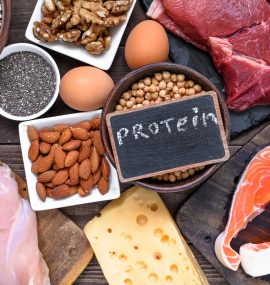Recommended daily allowance may not be enough
Even out protein intake over the day
Sarcopenia refers to the gradual loss of lean muscle mass and reduced physical strength and endurance. Sedentary older adults often exhibit sarcopenia. Regular aerobic and resistance exercise can lessen or stop the progression of sarcopenia. Adequate nutrition, especially sufficient protein and energy intake, also helps limit age-related losses in muscle mass, strength, and function. Thus, the combination of physical exercise and adequate nutrition can help maintain muscle mass and function and forestall sarcopenia.
The US Department of Agriculture establishes Recommended Daily Allowances (RDA) for various nutrients, including protein. The current RDA for protein is 0.8 grams per kilogram of body weight per day. A recent review proposed that this level is less than optimal for older adults. Plus, several factors may cause protein intake to decline in elders. Reasons include reduced energy needs, difficulty acquiring and preparing nutritionally adequate food, and decreased ability to smell and taste food.
Recent studies show that long-term intake of the RDA-level of protein leads to reduced lean muscle mass in older people. Higher protein intake is associated with slower loss of strength and frailty. Another line of research shows that physical exercise helps skeletal muscles synthesize protein, especially after a meal. Finally, consumption of carbohydrates with protein appears to blunt protein synthesis in the skeletal muscles of older people.
The European Society for Clinical Nutrition and Metabolism hosted a Workshop on Protein Requirements in the Elderly in 2013. These recommendations arose from that workshop: 1) Daily intake of at least 1.0 - 1.2 grams of protein per kilogram of body weight. 2) Malnourished older people should increase their daily protein intake to 1.2 - 1.5 grams of protein per kilogram of body weight, with even higher amounts for individuals with severe illness or injury. 3) Regular physical activity including resistance training and aerobic exercise.
Recent studies suggest that the pattern of daily protein consumption affects its ability to support muscle protein synthesis. Researchers in Texas recruited 8 participants (5 males, 3 females) to determine if eating equal amounts of protein at each daily meal would lead to more muscle protein synthesis than eating most of the protein at dinner. Americans typically eat most of their daily protein at dinner and little for breakfast.
The participants ate one of two meal types. (1) 90 grams of high-quality protein per day for seven days in equal amounts at daily meals (about 30 grams each). (2) 90 grams of high-quality protein per day for seven days with most of the protein at dinner (63 grams), 11 grams at breakfast, and 16 grams at lunch. Over a 24-hour period, participants who ate equal amounts of protein at each meal synthesized about 30 percent more muscle protein compared participants who ate most of their protein at dinner. Thus, some researchers now recommend eating 25 – 30 grams of protein at each daily meal to promote maximum muscle protein synthesis.
To minimize your risk of sarcopenia, exercise regularly (both resistance training and aerobic activity) and eat 25 – 30 grams of protein at each daily meal.








